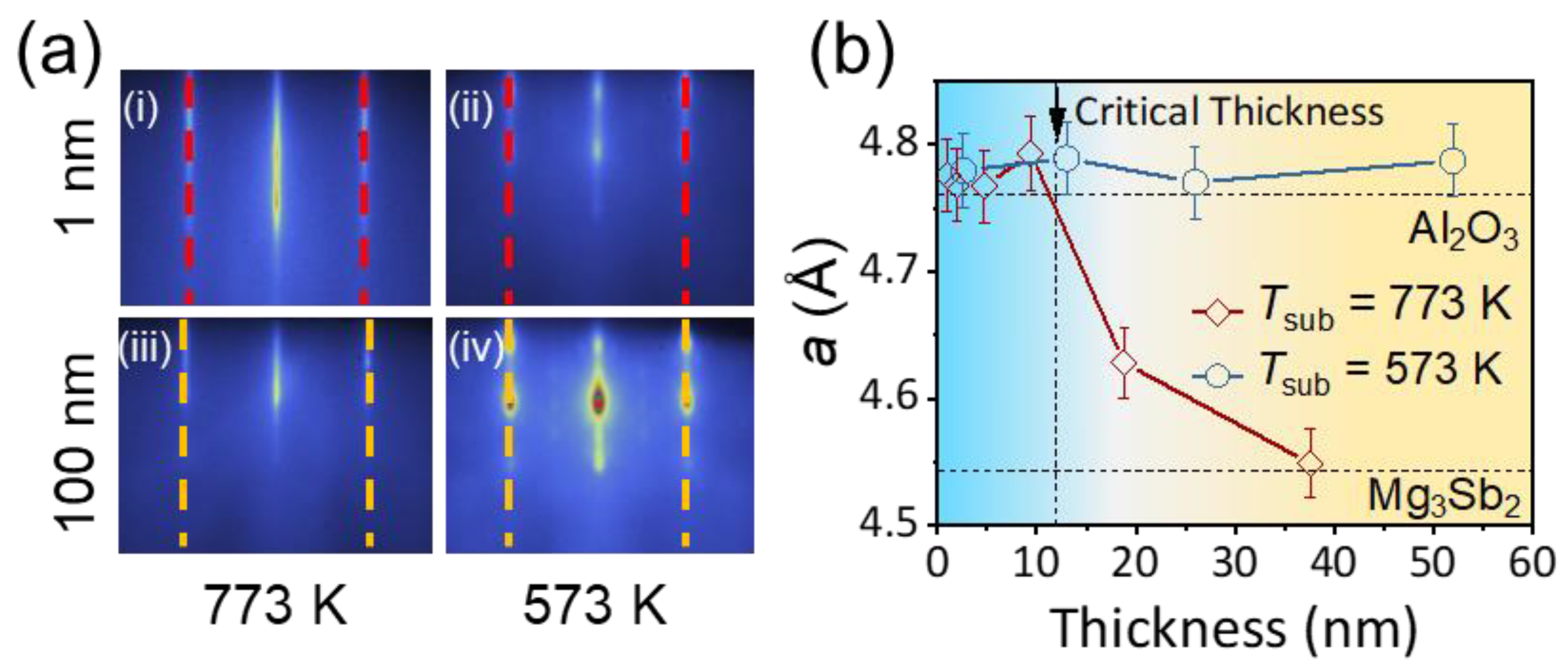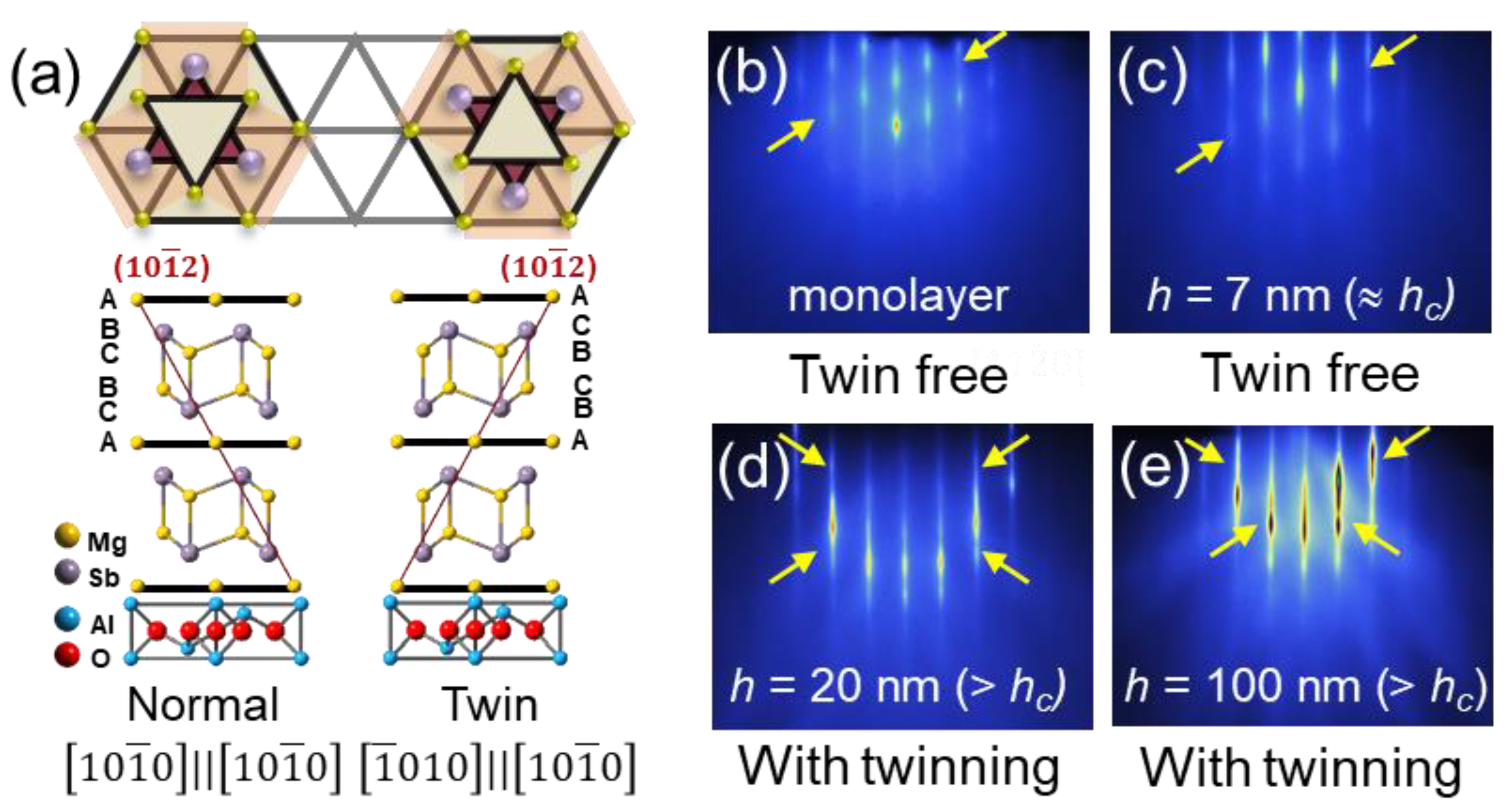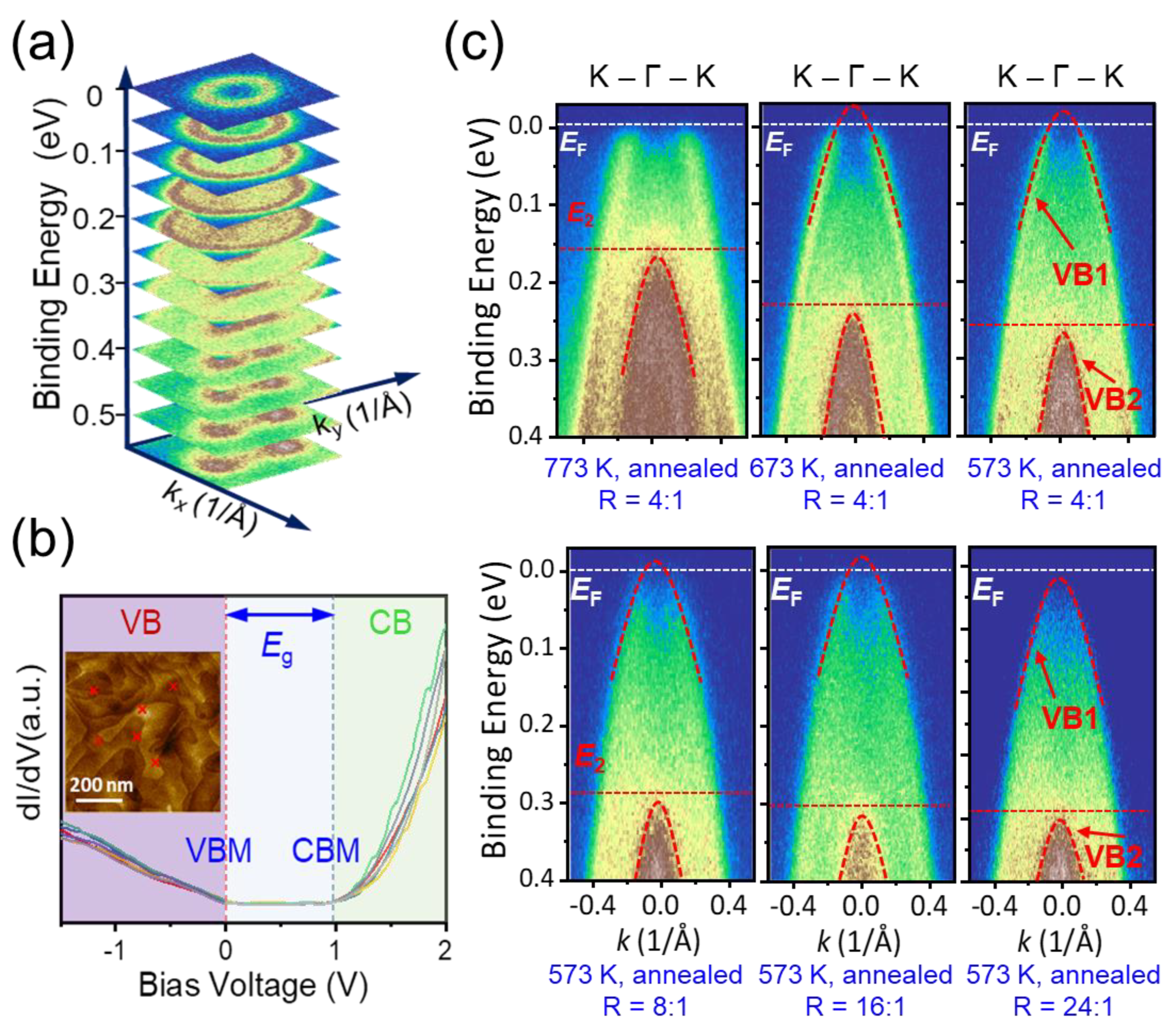Temperature-Driven Twin Structure Formation and Electronic Structure of Epitaxially Grown Mg3Sb2 Films on Mismatched Substrates
Abstract
:1. Introduction
2. Materials and Methods
3. Results
3.1. Lattice-Mismatched Epitaxial Growth of Mg3Sb2
3.2. Growth Mode and Epitaxial Strain Control
3.3. Detection and Manipulation of the Twin Structure
3.4. Band Structure and the Tuning of EF
4. Conclusions
Supplementary Materials
Author Contributions
Funding
Data Availability Statement
Conflicts of Interest
References
- Toberer, E.S.; May, A.F.; Snyder, G.J. Zintl Chemistry for Designing High Efficiency Thermoelectric Materials. Chem. Mater. 2010, 22, 624–634. [Google Scholar] [CrossRef]
- Kauzlarich, S.M.; Brown, S.R.; Jeffrey Snyder, G. Zintl phases for thermoelectric devices. J. Chem. Soc. Dalton Trans. 2007, 21, 2099–2107. [Google Scholar] [CrossRef] [PubMed] [Green Version]
- Snyder, G.J.; Toberer, E.S. Complex Thermoelectric Materials. Nat. Mater. 2008, 7, 105–114. [Google Scholar] [CrossRef] [PubMed] [Green Version]
- Ovchinnikov, A.; Chanakian, S.; Zevalkink, A.; Bobev, S. Ultralow Thermal Conductivity and High Thermopower in a New Family of Zintl Antimonides Ca10MSb9 (M = Ga, In, Mn, Zn) with Complex Structures and Heavy Disorder. Chem. Mater. 2021, 33, 3172–3186. [Google Scholar] [CrossRef]
- Zhang, J.; Song, L.; Pedersen, S.H.; Yin, H.; Hung, L.T.; Iversen, B.B. Discovery of high-performance low-cost n-type Mg3Sb2-based thermoelectric materials with multi-valley conduction bands. Nat. Commun. 2017, 8, 13901. [Google Scholar] [CrossRef] [Green Version]
- Shi, X.; Sun, C.; Bu, Z.; Zhang, X.; Wu, Y.; Lin, S.; Li, W.; Faghaninia, A.; Jain, A.; Pei, Y. Revelation of Inherently High Mobility Enables Mg3Sb2 as a Sustainable Alternative to N-Bi2Te3 Thermoelectrics. Adv. Sci. 2019, 6, 1802286. [Google Scholar] [CrossRef] [Green Version]
- Imasato, K.; Kang, S.D.; Snyder, G.J. Exceptional thermoelectric performance in Mg3Sb0.6Bi1.4 for low-grade waste heat recovery. Energy Environ. Sci. 2019, 12, 965–971. [Google Scholar] [CrossRef] [Green Version]
- Shi, X.; Zhang, X.; Ganose, A.; Park, J.; Sun, C.; Chen, Z.; Lin, S.; Li, W.; Jain, A.; Pei, Y. Compromise between band structure and phonon scattering in efficient N-Mg3Sb2-XBix thermoelectrics. Mater. Today Phys. 2021, 18, 1–6. [Google Scholar] [CrossRef]
- Imasato, K.; Kang, S.D.; Ohno, S.; Snyder, G.J. Band engineering in Mg3Sb2 by alloying with Mg3Bi2 for enhanced thermoelectric performance. Mater. Horiz. 2018, 5, 59–64. [Google Scholar] [CrossRef]
- Imasato, K.; Fu, C.; Pan, Y.; Wood, M.; Kuo, J.J.; Felser, C.; Snyder, G.J. Metallic N-Type Mg3Sb2 Single Crystals Demonstrate the Absence of Ionized Impurity Scattering and Enhanced Thermoelectric Performance. Adv. Mater. 2020, 32, e1908218. [Google Scholar] [CrossRef]
- Kanno, T.; Tamaki, H.; Sato, H.K.; Kang, S.D.; Ohno, S.; Imasato, K.; Kuo, J.J.; Snyder, G.J.; Miyazaki, Y. Enhancement of average thermoelectric figure of merit by increasing the grain-size of Mg3.2Sb1.5Bi0.49Te0.01. Appl. Phys. Lett. 2018, 112, 033903. [Google Scholar] [CrossRef] [Green Version]
- Kuo, J.J.; Kang, S.D.; Imasato, K.; Tamaki, H.; Ohno, S.; Kanno, T.; Snyder, G.J. Grain boundary dominated charge transport in Mg3Sb2-based compounds. Energy Environ. Sci. 2018, 11, 429–434. [Google Scholar] [CrossRef] [Green Version]
- Huang, S.; Wang, Z.; Xiong, R.; Yu, H.; Shi, J. Significant enhancement in thermoelectric performance of Mg3Sb2 from bulk to two-dimensional mono layer. Nano Energy 2019, 62, 212–219. [Google Scholar] [CrossRef]
- Dresselhaus, M.S.; Chen, G.; Tang, M.Y.; Yang, R.; Lee, H.; Wang, D.; Ren, Z.; Fleurial, J.P.; Gogna, P. New Directions for Low-Dimensional Thermoelectric Materials. Adv. Mater. 2007, 19, 1043–1053. [Google Scholar] [CrossRef]
- Zhang, J.; Song, L.; Madsen, G.K.H.; Fischer, K.F.F.; Zhang, W.; Shi, X.; Iversen, B.B. Designing high-performance layered thermoelectric materials through orbital engineering. Nat. Commun. 2016, 7, 10892. [Google Scholar] [CrossRef] [Green Version]
- Zhang, J.; Song, L.; Iversen, B.B. Insights into the design of thermoelectric Mg3Sb2 and its analogs by combining theory and experiment. npj Comput. Mater. 2019, 5, 76. [Google Scholar] [CrossRef] [Green Version]
- Zhang, X.; Jin, L.; Dai, X.; Liu, G. Topological Type-II Nodal Line Semimetal and Dirac Semimetal State in Stable Kagome Compound Mg3Bi2. J. Phys. Chem. Lett. 2017, 8, 4814–4819. [Google Scholar] [CrossRef]
- Zhou, T.; Zhu, X.-G.; Tong, M.; Zhang, Y.; Luo, X.-B.; Xie, X.; Feng, W.; Chen, Q.; Tan, S.; Wang, Z.-Y.; et al. Experimental Evidence of Topological Surface States in Mg3Bi2 Films Grown by Molecular Beam Epitaxy. Chin. Phys. Lett. 2019, 36, 117303. [Google Scholar] [CrossRef] [Green Version]
- Chang, T.R.; Pletikosic, I.; Kong, T.; Bian, G.; Huang, A.; Denlinger, J.; Kushwaha, S.K.; Sinkovic, B.; Jeng, H.T.; Valla, T.; et al. Realization of a Type-II Nodal-Line Semimetal in Mg3Bi2. Adv. Sci. 2019, 6, 1800897. [Google Scholar] [CrossRef] [Green Version]
- Baer, D.R.; Windisch, C.F.; Engelhard, M.H.; Danielson, M.J.; Jones, R.H.; Vetrano, J.S. Influence of Mg on the corrosion of Al. J. Vac. Sci. Technol. A Vac. Surf. Film. 2000, 18, 131–136. [Google Scholar] [CrossRef]
- Ghasali, E.; Bordbar-Khiabani, A.; Alizadeh, M.; Mozafari, M.; Niazmand, M.; Kazemzadeh, H.; Ebadzadeh, T. Corrosion behavior and in-vitro bioactivity of porous Mg/Al2O3 and Mg/Si3N4 metal matrix composites fabricated using microwave sintering process. Mater. Chem. Phys. 2019, 225, 331–339. [Google Scholar] [CrossRef]
- Song, G.; Atrens, A. Understanding Magnesium Corrosion—A Framework for Improved Alloy Performance. Adv. Eng. Mater. 2003, 5, 837–858. [Google Scholar] [CrossRef]
- Das, T.K.; Das, N.C. Preparation of 1D, 2D, and 3D Nanomaterials for Water Treatment; Elsevier Inc.: Amsterdam, The Netherlands, 2022; ISBN 9780323854450. [Google Scholar]
- Das, T.K.; Das, N.C. Advances on catalytic reduction of 4-nitrophenol by nanostructured materials as benchmark reaction. Int. Nano Lett. 2022, 12, 223–242. [Google Scholar] [CrossRef]
- Nakano, M.; Wang, Y.; Kashiwabara, Y.; Matsuoka, H.; Iwasa, Y. Layer-by-Layer Epitaxial Growth of Scalable WSe2 on Sapphire by Molecular Beam Epitaxy. Nano Lett. 2017, 17, 5595–5599. [Google Scholar] [CrossRef] [Green Version]
- Zhang, J.; Song, L.; Sist, M.; Tolborg, K.; Iversen, B.B. Chemical bonding origin of the unexpected isotropic physical properties in thermoelectric Mg3Sb2 and related materials. Nat. Commun. 2018, 9, 4716. [Google Scholar] [CrossRef] [Green Version]
- Calderón-Cueva, M.; Peng, W.; Clarke, S.M.; Ding, J.; Brugman, B.L.; Levental, G.; Balodhi, A.; Rylko, M.; Delaire, O.; Walsh, J.P.S.; et al. Anisotropic Structural Collapse of Mg3Sb2 and Mg3Bi2 at High Pressure. Chem. Mater. 2021, 33, 567–573. [Google Scholar] [CrossRef]
- Zhou, D.W.; Liu, J.S.; Xu, S.H.; Peng, P. Thermal stability and elastic properties of Mg3Sb2 and Mg3Bi2 phases from first-principles calculations. Phys. B Condens. Matter 2010, 405, 2863–2868. [Google Scholar] [CrossRef]
- Margenau, H. Van der waals forces. Rev. Mod. Phys. 1939, 11, 1–35. [Google Scholar] [CrossRef]
- Kim, J.-Y.; Koo, T.Y.; Park, J.-H. Orbital and Bonding Anisotropy in a Half-FilledGaFeO3 Magnetoelectric Ferrimagnet. Phys. Rev. Lett. 2006, 96, 047205. [Google Scholar] [CrossRef] [Green Version]
- Tiadi, M.; Battabyal, M.; Jain, P.K.; Chauhan, A.; Satapathy, D.K.; Gopalan, R. Enhancing the thermoelectric efficiency in p-type Mg3Sb2 via Mg site co-doping. Sustain. Energy Fuels 2021, 5, 4104–4114. [Google Scholar] [CrossRef]
- Tuschel, D. Stress, Strain, and Raman Spectroscopy. Spectroscopy 2019, 34, 10–21. [Google Scholar]
- Dodson, B.W.; Tsao, J.Y. Relaxation of strained-layer semiconductor structures via plastic flow. Appl. Phys. Lett. 1987, 51, 1325–1327. [Google Scholar] [CrossRef]
- Fox, B.A.; Jesser, W.A. The effect of frictional stress on the calculation of critical thickness in epitaxy. J. Appl. Phys. 1990, 68, 2801–2808. [Google Scholar] [CrossRef]
- Sohi, P.; Martin, D.; Grandjean, N. Critical thickness of GaN on AlN: Impact of growth temperature and dislocation density. Semicond. Sci. Technol. 2017, 32, 75010. [Google Scholar] [CrossRef]
- Bauer, E.; van der Merwe, J.H. Structure and growth of crystalline superlattices: From monolayer to superlattice. Phys. Rev. B 1986, 33, 3657–3672. [Google Scholar] [CrossRef] [PubMed]
- Freund, L.B. Dislocation Mechanisms of Relaxation in Strained Epitaxial Films. MRS Bull. 1992, 17, 52–60. [Google Scholar] [CrossRef]
- Chen, Y.; Song, H.; Li, D.; Sun, X.; Jiang, H.; Li, Z.; Miao, G.; Zhang, Z.; Zhou, Y. Influence of the growth temperature of AlN nucleation layer on AlN template grown by high-temperature MOCVD. Mater. Lett. 2014, 114, 26–28. [Google Scholar] [CrossRef]
- Lee, S.R.; West, A.M.; Allerman, A.A.; Waldrip, K.E.; Follstaedt, D.M.; Provencio, P.P.; Koleske, D.D.; Abernathy, C.R. Effect of threading dislocations on the Bragg peakwidths of GaN, AlGaN, and AlN heterolayers. Appl. Phys. Lett. 2005, 86, 241904. [Google Scholar] [CrossRef]
- Ben, J.; Sun, X.; Jia, Y.; Jiang, K.; Shi, Z.; Liu, H.; Wang, Y.; Kai, C.; Wu, Y.; Li, D. Defect evolution in AlN templates on PVD-AlN/sapphire substrates by thermal annealing. Crystengcomm 2018, 20, 4623–4629. [Google Scholar] [CrossRef]
- Capellini, G.; De Seta, M.; Busby, Y.; Pea, M.; Evangelisti, F.; Nicotra, G.; Spinella, C.; Nardone, M.; Ferrari, C. Strain relaxation in high Ge content SiGe layers deposited on Si. J. Appl. Phys. 2010, 107, 063504. [Google Scholar] [CrossRef]
- Nakao, H.; Yao, T. Surface Lattice Strain Relaxation at the Initial Stage of Heteroepitaxial Growth of InxGa1-x as on GaAs by Molecular Beam Epitaxy. Jpn. J. Appl. Phys. 1989, 28, L352–L355. [Google Scholar] [CrossRef]
- Laaksonen, K.; Ganchenkova, M.G.; Nieminen, R.M. Minor Component Ordering in Wurtzite Ga1-XInxN and Ga1-XAlxN. Phys. B Condens. Matter 2006, 376–377, 502–506. [Google Scholar] [CrossRef]
- Nichols, J.; Terzic, J.; Bittle, E.G.; Korneta, O.B.; De Long, L.E.; Brill, J.W.; Cao, G.; Seo, S.S.A. Tuning electronic structure via epitaxial strain in Sr2IrO4 thin films. Appl. Phys. Lett. 2013, 102, 141908. [Google Scholar] [CrossRef] [Green Version]
- Gan, Q.; Rao, R.A.; Eom, C.B.; Garrett, J.L.; Lee, M. Direct measurement of strain effects on magnetic and electrical properties of epitaxial SrRuO3 thin films. Appl. Phys. Lett. 1998, 72, 978–980. [Google Scholar] [CrossRef]
- Lee, D.; Yoon, A.; Jang, S.Y.; Yoon, J.-G.; Chung, J.-S.; Kim, M.; Scott, J.F.; Noh, T.W. Giant Flexoelectric Effect in Ferroelectric Epitaxial Thin Films. Phys. Rev. Lett. 2011, 107, 057602. [Google Scholar] [CrossRef]
- Kampmeier, J.; Borisova, S.; Plucinski, L.; Luysberg, M.; Mussler, G.; Grützmacher, D. Suppressing Twin Domains in Molecular Beam Epitaxy Grown Bi2Te3 Topological Insulator Thin Films. Cryst. Growth Des. 2015, 15, 390–394. [Google Scholar] [CrossRef]
- Ohno, S.; Imasato, K.; Anand, S.; Tamaki, H.; Kang, S.D.; Gorai, P.; Sato, H.K.; Toberer, E.S.; Kanno, T.; Snyder, G.J. Phase Boundary Mapping to Obtain N-type Mg3Sb2-Based Thermoelectrics. Joule 2018, 2, 141–154. [Google Scholar] [CrossRef] [Green Version]
- Mao, J.; Wu, Y.; Song, S.; Zhu, Q.; Shuai, J.; Liu, Z.; Pei, Y.; Ren, Z. Defect Engineering for Realizing High Thermoelectric Performance in N-Type Mg3Sb2-Based Materials. ACS Energy Lett. 2017, 2, 2245–2250. [Google Scholar] [CrossRef]
- Shuai, J.; Ge, B.; Mao, J.; Song, S.; Wang, Y.; Ren, Z. Significant Role of Mg Stoichiometry in Designing High Thermoelectric Performance for Mg3(Sb,Bi)2-Based n-Type Zintls. J. Am. Chem. Soc. 2018, 140, 1910–1915. [Google Scholar] [CrossRef]
- Li, J.; Zhang, S.; Zheng, S.; Zhang, Z.; Wang, B.; Chen, L.; Lu, G. Defect Chemistry for N-Type Doping of Mg3Sb2-Based Thermoelectric Materials. J. Phys. Chem. C 2019, 123, 20781–20788. [Google Scholar] [CrossRef]
- Pan, Y.; Yao, M.; Hong, X.; Zhu, Y.; Fan, F.; Imasato, K.; He, Y.; Hess, C.; Fink, J.; Yang, J.; et al. Mg3(Bi,Sb)2 single crystals towards high thermoelectric performance. Energy Environ. Sci. 2020, 13, 1717–1724. [Google Scholar] [CrossRef]
- Kim, S.; Kim, C.; Hong, Y.-K.; Onimaru, T.; Suekuni, K.; Takabatake, T.; Jung, M.-H. Thermoelectric properties of Mn-doped Mg–Sb single crystals. J. Mater. Chem. A 2014, 2, 12311–12316. [Google Scholar] [CrossRef]
- Sarangan, A. Physical and Chemical Vapor Deposition. In Nanofabrication; CRC Press: Boca Raton, FL, USA, 2016; ISBN 9781315370514. [Google Scholar]
- Shi, X.; Han, Z.Q.; Peng, X.L.; Richard, P.; Qian, T.; Wu, X.X.; Qiu, M.W.; Wang, S.C.; Hu, J.P.; Sun, Y.J.; et al. Enhanced superconductivity accompanying a Lifshitz transition in electron-doped FeSe monolayer. Nat. Commun. 2017, 8, 14988. [Google Scholar] [CrossRef] [PubMed]






Publisher’s Note: MDPI stays neutral with regard to jurisdictional claims in published maps and institutional affiliations. |
© 2022 by the authors. Licensee MDPI, Basel, Switzerland. This article is an open access article distributed under the terms and conditions of the Creative Commons Attribution (CC BY) license (https://creativecommons.org/licenses/by/4.0/).
Share and Cite
Xie, S.; Ouyang, Y.; Liu, W.; Yan, F.; Luo, J.; Li, X.; Wang, Z.; Liu, Y.; Tang, X. Temperature-Driven Twin Structure Formation and Electronic Structure of Epitaxially Grown Mg3Sb2 Films on Mismatched Substrates. Nanomaterials 2022, 12, 4429. https://doi.org/10.3390/nano12244429
Xie S, Ouyang Y, Liu W, Yan F, Luo J, Li X, Wang Z, Liu Y, Tang X. Temperature-Driven Twin Structure Formation and Electronic Structure of Epitaxially Grown Mg3Sb2 Films on Mismatched Substrates. Nanomaterials. 2022; 12(24):4429. https://doi.org/10.3390/nano12244429
Chicago/Turabian StyleXie, Sen, Yujie Ouyang, Wei Liu, Fan Yan, Jiangfan Luo, Xianda Li, Ziyu Wang, Yong Liu, and Xinfeng Tang. 2022. "Temperature-Driven Twin Structure Formation and Electronic Structure of Epitaxially Grown Mg3Sb2 Films on Mismatched Substrates" Nanomaterials 12, no. 24: 4429. https://doi.org/10.3390/nano12244429
APA StyleXie, S., Ouyang, Y., Liu, W., Yan, F., Luo, J., Li, X., Wang, Z., Liu, Y., & Tang, X. (2022). Temperature-Driven Twin Structure Formation and Electronic Structure of Epitaxially Grown Mg3Sb2 Films on Mismatched Substrates. Nanomaterials, 12(24), 4429. https://doi.org/10.3390/nano12244429







